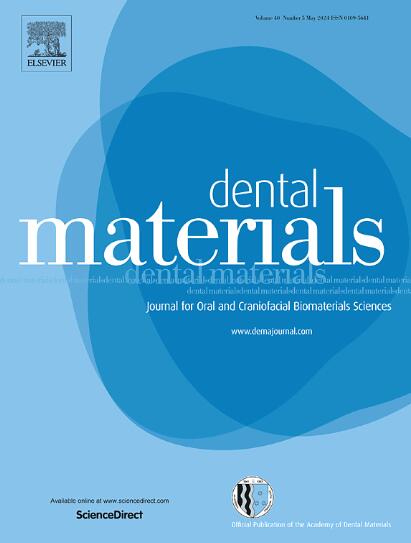Longevity and risk factors of CAD-CAM manufactured implant-supported all-ceramic crowns - A prospective, multi-center, practice-based cohort study
IF 4.6
1区 医学
Q1 DENTISTRY, ORAL SURGERY & MEDICINE
引用次数: 0
Abstract
Objectives
The aim of this prospective, multi-center, practice-based cohort study was to analyze factors associated with the success of implant supported all-ceramic single-unit crowns, made by computer-aided-design/computer-aided-manufacturing (CAD-CAM).
Methods
All-ceramic crowns placed in a private practice-based research network (Ceramic Success Analysis, AG Keramik) were analyzed. Data from 567patients with CAD-CAM implant supported all-ceramic crowns placed between 2008–2023 by 54dentists were evaluated. Firstly, all crowns with at least one follow-up control were included (n = 907). Secondly, all crowns being followed up for ≥ 5years and all failures were included (n = 151). At the latest follow-up visit, crowns were considered as successful (not failed) if they were still in function without the need for additional therapy. Multi-level Cox proportional hazards models were used to evaluate the association between a range of predictors and time of success.
Results
Within a mean follow-up period (SD) of 2.5 (2)years (first scenario) and 6.2 (1.2)years (second scenario) [maximum:12years], 27crowns failed (annual failure rate [AFR]:0.74 %). The main failure types were decementation, (n = 11), fracture of the ceramic (n = 4) or Ti-Base (n = 4). In 5-year-scenario, crowns fabricated in the laboratory had 26times lower failure rate than those fabricated chairside (95 %CI:0.0–0.7;p = 0.038). Furthermore, the use of a silane (HR:0.051;95 %CI:0.0–0.5;p = 0.014) and etching of the ceramic (HR:0.053;95 %CI:0.0–0.8;p = 0.035) resulted in a significantly higher risk for failure than their non-use.
Significance
For CAD-CAM manufactured implant supported all-ceramic crowns, high success rates were found in up to 12-year evaluation. Furthermore, after 5years, no patient-or implant-level factors, but operative-level factor (i.e.fabrication method, use of silane/etching) were significantly associated with failure.
The study was registered in the German Clinical Trials Register (DRKS-ID: DRKS00020271).
CAD-CAM 制造的种植体支撑全瓷冠的寿命和风险因素 - 一项基于实践的前瞻性多中心队列研究。
研究目的这项前瞻性、多中心、基于实践的队列研究旨在分析通过计算机辅助设计/计算机辅助制造(CAD-CAM)制作的种植体支持全瓷单冠的成功相关因素:方法:分析了在一个以私人诊所为基础的研究网络(Ceramic Success Analysis, AG Keramik)中安装的全瓷牙冠。对 54 名牙医在 2008-2023 年间为 567 名患者安装的 CAD-CAM 种植体支持全瓷牙冠的数据进行了评估。首先,纳入了所有至少有一个随访对照的牙冠(n = 907)。其次,所有随访时间超过 5 年的牙冠和所有失败的牙冠都被纳入其中(n = 151)。在最近一次随访中,如果牙冠仍能正常使用而无需额外治疗,则视为成功(非失败)。多层次考克斯比例危险模型用于评估一系列预测因素与成功时间之间的关系:在平均 2.5 (2) 年(第一种情况)和 6.2 (1.2) 年(第二种情况)[最长:12 年]的随访时间(标清)内,有 27 例手术失败(年失败率 [AFR]:0.74%)。主要故障类型为脱落(11 个)、陶瓷断裂(4 个)或钛基底(4 个)。在 5 年的情况下,在技工室制作的牙冠的失败率比在椅旁制作的低 26 倍(95 %CI:0.0-0.7;P = 0.038)。此外,使用硅烷(HR:0.051;95 %CI:0.0-0.5;p = 0.014)和蚀刻陶瓷(HR:0.053;95 %CI:0.0-0.8;p = 0.035)导致失败的风险明显高于不使用硅烷和蚀刻陶瓷:CAD-CAM制造的种植体支持全瓷冠在长达12年的评估中成功率很高。此外,5年后,患者或种植体层面的因素均与失败无显著关联,但手术层面的因素(即制作方法、硅烷/蚀刻的使用)与失败有显著关联。该研究已在德国临床试验注册中心注册(DRKS-ID:DRKS00020271)。
本文章由计算机程序翻译,如有差异,请以英文原文为准。
求助全文
约1分钟内获得全文
求助全文
来源期刊

Dental Materials
工程技术-材料科学:生物材料
CiteScore
9.80
自引率
10.00%
发文量
290
审稿时长
67 days
期刊介绍:
Dental Materials publishes original research, review articles, and short communications.
Academy of Dental Materials members click here to register for free access to Dental Materials online.
The principal aim of Dental Materials is to promote rapid communication of scientific information between academia, industry, and the dental practitioner. Original Manuscripts on clinical and laboratory research of basic and applied character which focus on the properties or performance of dental materials or the reaction of host tissues to materials are given priority publication. Other acceptable topics include application technology in clinical dentistry and dental laboratory technology.
Comprehensive reviews and editorial commentaries on pertinent subjects will be considered.
 求助内容:
求助内容: 应助结果提醒方式:
应助结果提醒方式:


